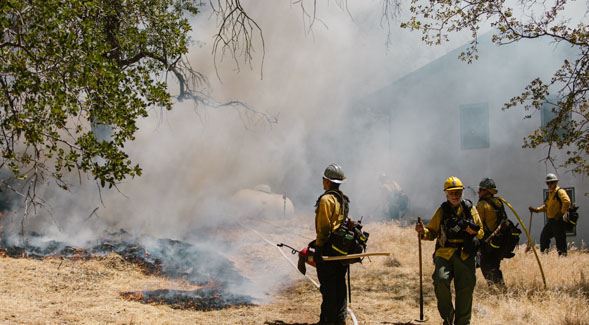Wildfires, Drought and the Season Ahead
Faculty experts offer preparedness tips and discuss changing trends in California.

Last year saw five of the worst California wildfires in the state's history, with more than 4 million acres burned and thousands of residents evacuated from their homes. Now the 2021 wildfire season is already proving damaging as the Dixie Fire continues to burn in northern Sierra Nevada and the Caldor Fire currently threatens South Lake Tahoe. In an effort to prevent more damage, California announced it is closing all national forests until later this month.
To find out what California residents and visitors need to be aware of this wildfire season and how to prepare, the SDSU News Team spoke to two San Diego State University professors who study wildfire spread: Assistant Professor of Mechanical Engineering Joaquin Camacho and Distinguished Professor Emeritus of Geography Doug Stow.
What are we seeing this wildfire season?
Stow: There was an earlier start of the season than normal, though mostly in NorCal thus far. Typically the largest and most intense fires in SoCal occur September through mid-November.
Are we seeing any trends during wildfire season?
Stow: The trend in California and much of the West has been for fire season to start earlier and finish later, if at all, and for larger fires to occur. The largest fires on record in California have occurred in the past five years.
Camacho: If the current drought continues, wildfire risks will remain high and wildfires could become an even larger problem.
Will wildfire seasons get worse moving forward?
Stow: Not necessarily worse, but we should expect fire seasons to continue to last longer and to have more extensive wildfires than in the recent past. Much of this depends on the persistence and recurrence of drought. What is less predictable are ignition sources, which are primarily anthropogenic — e.g., from electric utility defects during windy conditions. However, high amounts of tree mortality and occasional dry lightning storms will likely continue to influence large wildfire events in NorCal.
Camacho: The most direct impact is from the drought the Southwest is experiencing. A hope is that man-made fire hazards such as wildfire ignition by electrical lines and heavy equipment will be reduced due to upgraded infrastructure and greater awareness.
What should everyone know about wildfires and how to prevent them?
Stow: The main thing to know is that we generally cannot and will not prevent wildfires, so the best preparation is to reduce the potential for loss of life and structural damage, and to intelligently plan and permit land use development. This includes creating defensible spaces around and “hardening”, or installing fireproof features in a structure, in wildlands and wildland interface zones, and implementing early warning and effective evacuation strategies.
Camacho: An important point to understand is that wildfires are a natural occurrence in the Southwestern U.S. In this region, Smokey Bear is incorrect to say “only you can prevent forest fires” because lightning has driven the natural wildfire cycle before anthropogenic factors further exacerbated the problem. People and infrastructure also contribute to wildfires but there is no way to eliminate the threat of wildfires.
What can people do now to protect themselves and their homes and prepare?
Camacho: Most California suburbs are exposed to wildfire risks, unfortunately. Those living at the wildland-urban interface should actively learn about measures to modify their home and property to minimize the threat of fire spread. These measures include maximizing the area surrounding the home that is free of excessive brush and flammable materials. Members of the household should also make solid evacuation and communication plans.
More information on preparing for a wildfire and evacuation can be found on the Cal Fire website.
What are the effects of wildfires on the environment?
Stow: Most of the effects are positive, as fire is an important ecological disturbance agent of California ecosystems. However, the recent shift to more extensive and possibly intensive fires in the past decade or two has resulted in negative effects to the environment and hazards for humans, such as mudflows, severe erosion, and slope failures. Also, there is strong evidence that more frequent burning of Southern California chaparral (shrublands) along with more prolonged drought has resulted in some conversion to non-native grass-dominated plant communities.
Camacho: Many ecosystems in the Southwestern U.S. are adapted to include wildfires in a natural cycle. The problem is that drought and climate change are expanding wildfire occurrence to ecosystems that do not commonly have wildfires. The long-term effects of larger wildfires and expanded wildfire seasons are not yet known but short-term effects include disruption of ecosystems, increased carbon emissions and poor air quality.
Why should people care about wildfires and their effects on our environment?
Stow: Wildfires are an important part of the ecosystems in which we reside, work and recreate. Minimizing the negative effects of wildfires is an important and expensive endeavor. Besides the direct hazard of fire, smoke from wildfires is a potential health hazard to citizens over vast areas. Mitigation of potential fire hazards by electric utilities de-energizing power transmission infrastructure is critical to reducing a major ignition source, particularly during Santa Ana weather conditions, but also reduces people’s well-being when their power is turned off.



